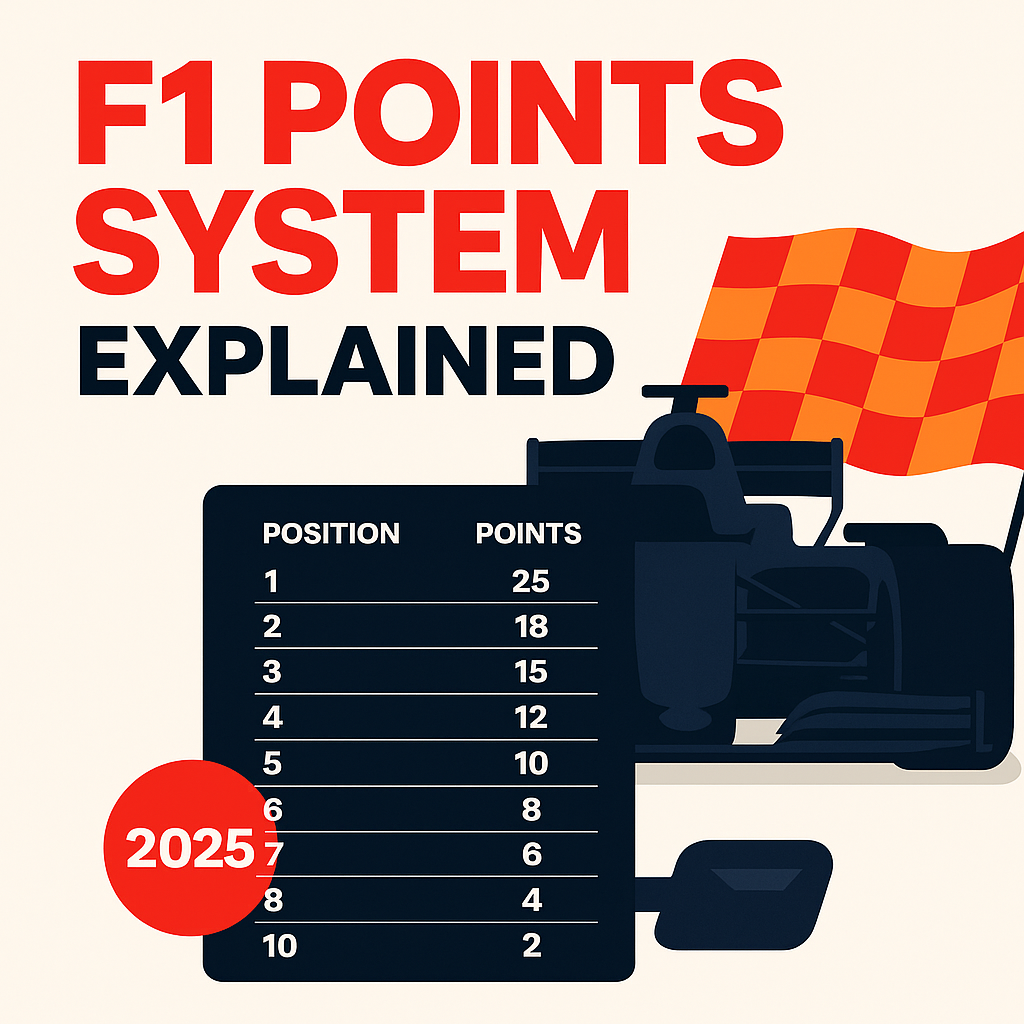F1 Points System Explained: How Drivers Win the Championship
If you’re new to Formula 1—or you’ve been away for a few seasons—the way points are awarded can feel confusing. Between sprints, shortened races and tie-breakers, it’s easy to get lost. This guide covers the 2025 setup clearly, with examples, so you’ll know exactly how the title is won.
TL;DR
- Grand Prix points go to the top 10 finishers on a 25–18–15–12–10–8–6–4–2–1 scale.
- On sprint weekends, the top eight in the sprint score 8–7–6–5–4–3–2–1.
- No fastest-lap bonus point in 2025.
- If a race is shortened, reduced points apply depending on distance completed.
- Drivers must complete at least 90% of the winner’s laps to be classified (and eligible for points).
- Ties are broken by countback: most wins, then most second places, etc.
The main race-day points scale
Every Grand Prix awards championship points to the top 10 classified finishers:
| Position | Points |
|---|---|
| 1st | 25 |
| 2nd | 18 |
| 3rd | 15 |
| 4th | 12 |
| 5th | 10 |
| 6th | 8 |
| 7th | 6 |
| 8th | 4 |
| 9th | 2 |
| 10th | 1 |
These points feed both the Drivers’ and Constructors’ championships (the team simply adds the points scored by its two drivers at each event).
2025 note: The fastest-lap bonus point (2019–2024) has been removed, so a driver’s race haul now depends solely on finishing position.
Sprint weekends: extra points on Saturday
Some Grands Prix feature a Sprint (a short race) with its own points. On those weekends, the top eight in the sprint score:
8–7–6–5–4–3–2–1
A separate Sprint Qualifying session sets the sprint grid; traditional qualifying sets Sunday’s Grand Prix grid. Winning both the sprint and the race nets 8 + 25 = 33 points for the weekend.
Shortened races: reduced points rules
Weather or incidents can force a race to run less than its scheduled distance. Since 2022, F1 uses a tiered system based on the percentage of race distance completed, with one precondition: at least two racing laps must be completed under green-flag conditions (no Safety Car or VSC) before any points are awarded.
Summary:
- < 2 green-flag laps: No points.
- ≥ 2 laps but < 25% distance: Points to P5 on 6–4–3–2–1.
- 25%–< 50%: Points to P9 on 13–10–8–6–5–4–3–2–1.
- 50%–< 75%: Points to P10 on 19–14–12–10–8–6–4–3–2–1.
- ≥ 75%: Full points (25–18–…–1).
For sprints, it’s simpler:
- < 50% distance (and still needing those two green laps): no points.
- ≥ 50% distance: full sprint points.
Classification: the 90% rule
To appear in the official results (and be eligible for points), a driver must be classified. That requires completing at least 90% of the winner’s lap count. You can retire late and still be classified if you’ve already crossed that threshold; you can also take the flag but be NC (not classified) if you didn’t reach 90%.
Tie-breakers: how a draw is decided
End-of-season ties are rare but not impossible. If two drivers or teams end on the same number points, the title goes to whoever has:
- More wins; if still tied,
- More second places; then
- More third places, and so on.
If that still doesn’t separate them, the FIA can apply other criteria—but modern F1 hasn’t needed that step.
Drivers vs Constructors (and why both matter)
Every point a driver scores also counts toward the Constructors’ Championship. That matters because prize money and commercial benefits are tied to the teams’ finishing positions. A constructor can win the team title even if neither of its drivers wins the drivers’ crown—consistency across both seats is huge.
FAQ: quick answers to common questions
What’s the maximum a driver can score on a sprint weekend?
33 points: 8 for the sprint win + 25 for the Grand Prix win.
Are there still points for pole position?
No. Pole brings pride and track position, but no championship points.
Can points be awarded if a race only ran behind the Safety Car?
No—two green-flag laps are required before any reduced-points table applies.
Do post-race penalties change points?
Yes. If penalties alter the final classification, the points are recalculated accordingly.
Worked example: a sprint weekend
- Sprint: Driver A finishes P3 → 6 points
- Grand Prix: Driver A finishes P2 → 18 points
- Weekend total: 24 points
If the Grand Prix were red-flagged at ~60% distance, P2 would pay 14 points (the 50–75% tier). The weekend would then total 20 points instead of 24.
Why dropping the fastest-lap point matters
The bonus point often encouraged late pit stops solely to chase purple sectors, sometimes affecting battles elsewhere. Removing it refocuses the reward on race results rather than a single hot lap. Strategically, you’ll see fewer “free stop for FL” plays and more emphasis on track position to the flag.
Final thoughts (and how to follow it in real time)
The current system rewards outright results while handling messy weekends fairly. With the fastest-lap point gone, championships should hinge a bit less on opportunistic gambles and a bit more on consistent finishing positions.
Want to see the title picture evolve as it happens? Track live standings throughout each weekend with Race Mate—and watch how every pass changes the championship in real time.
